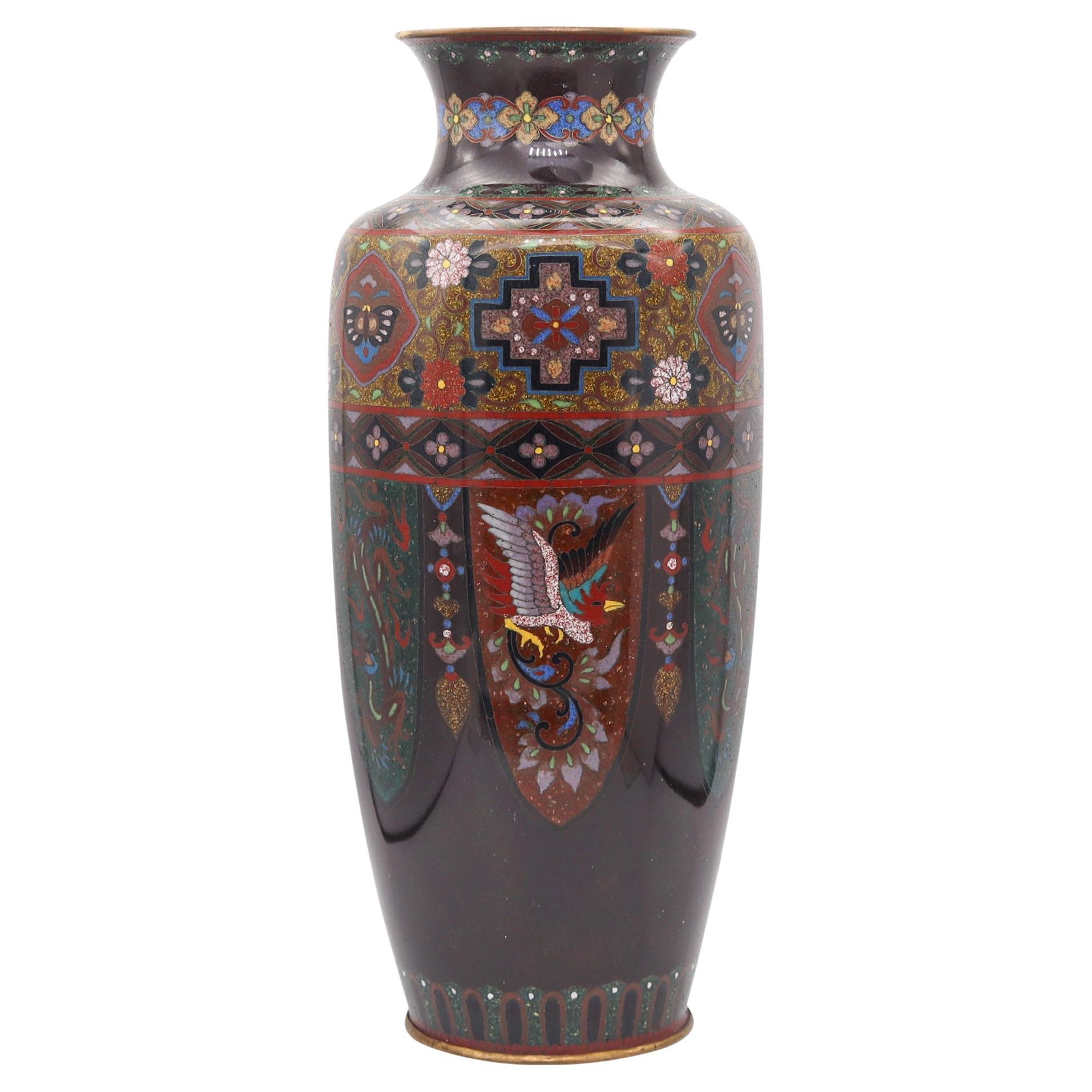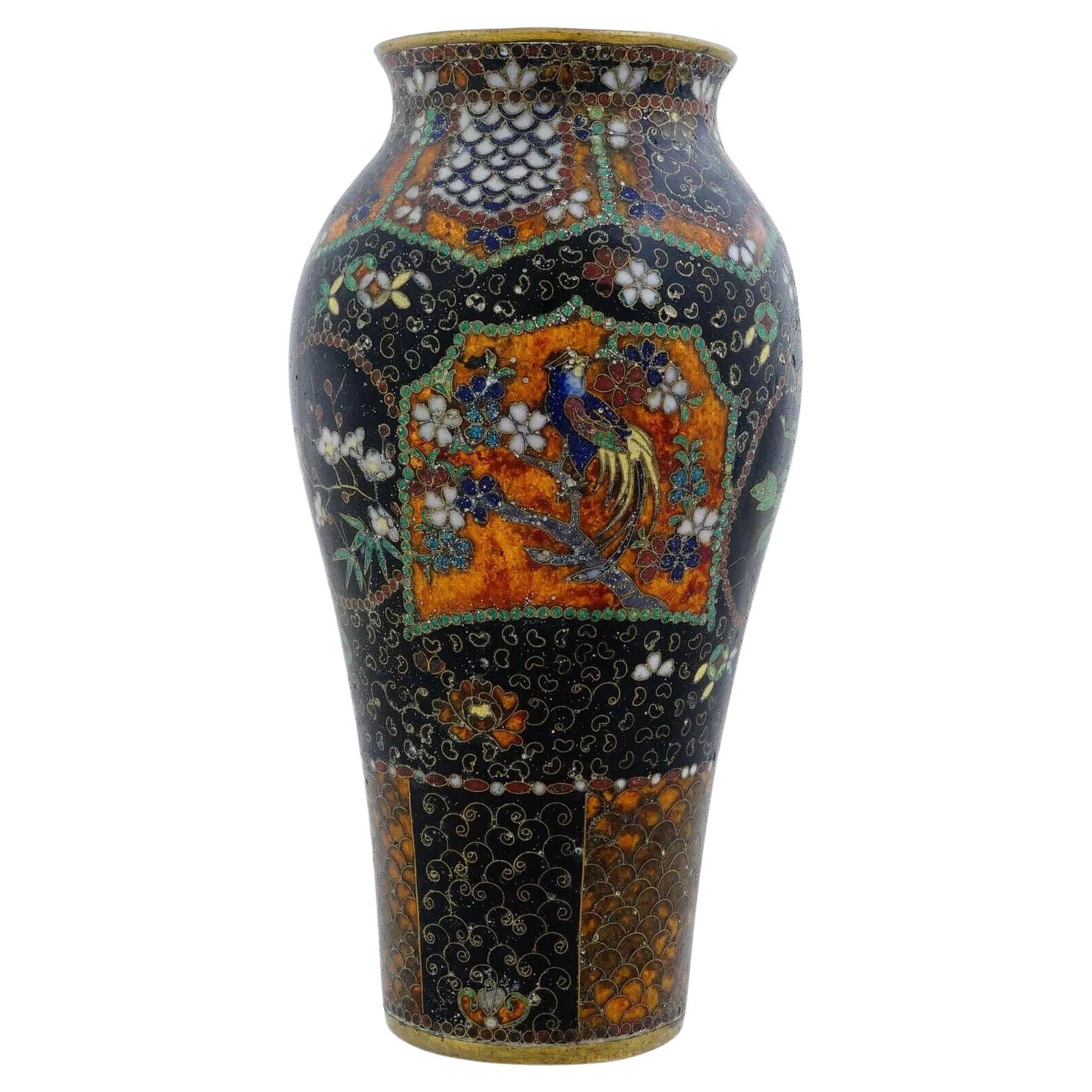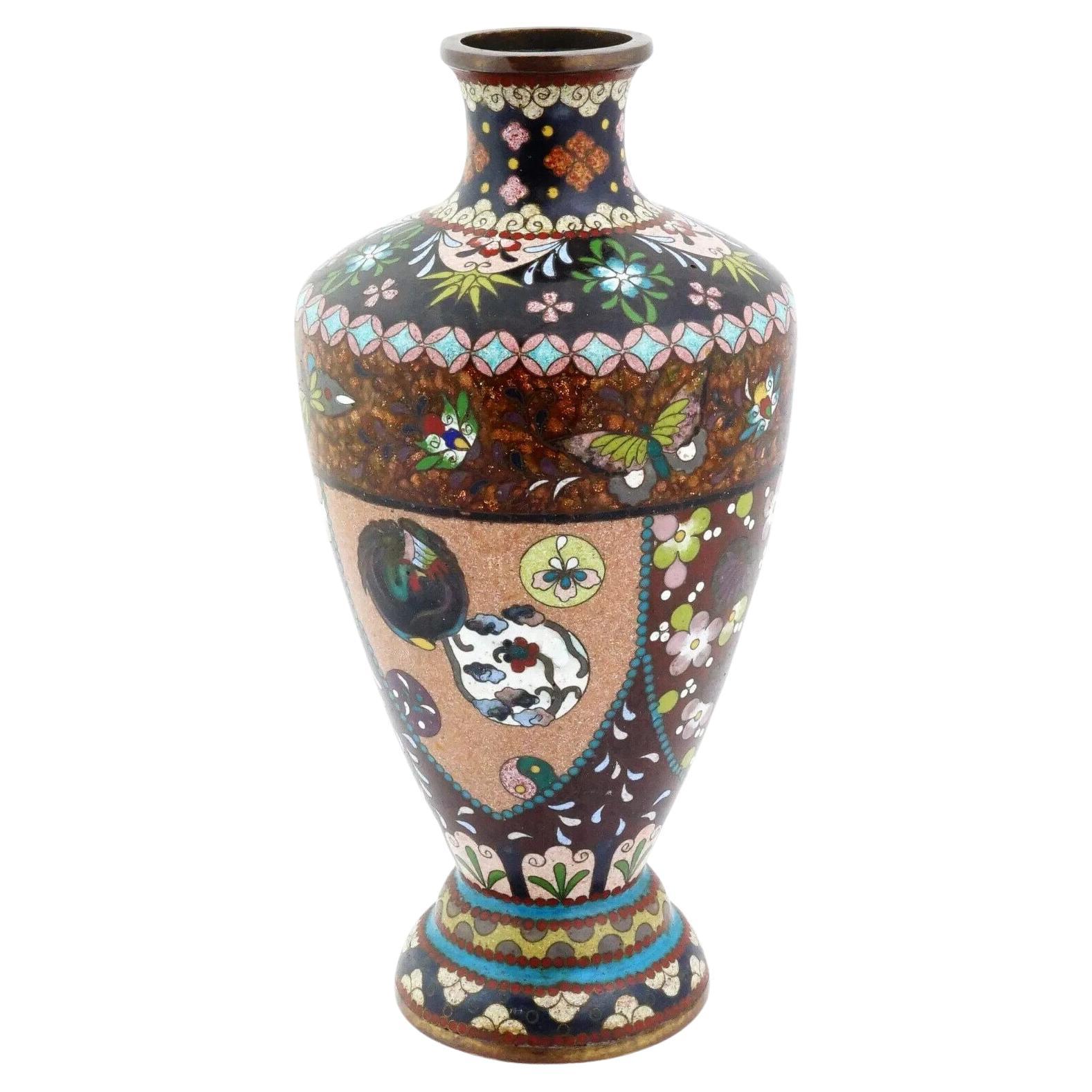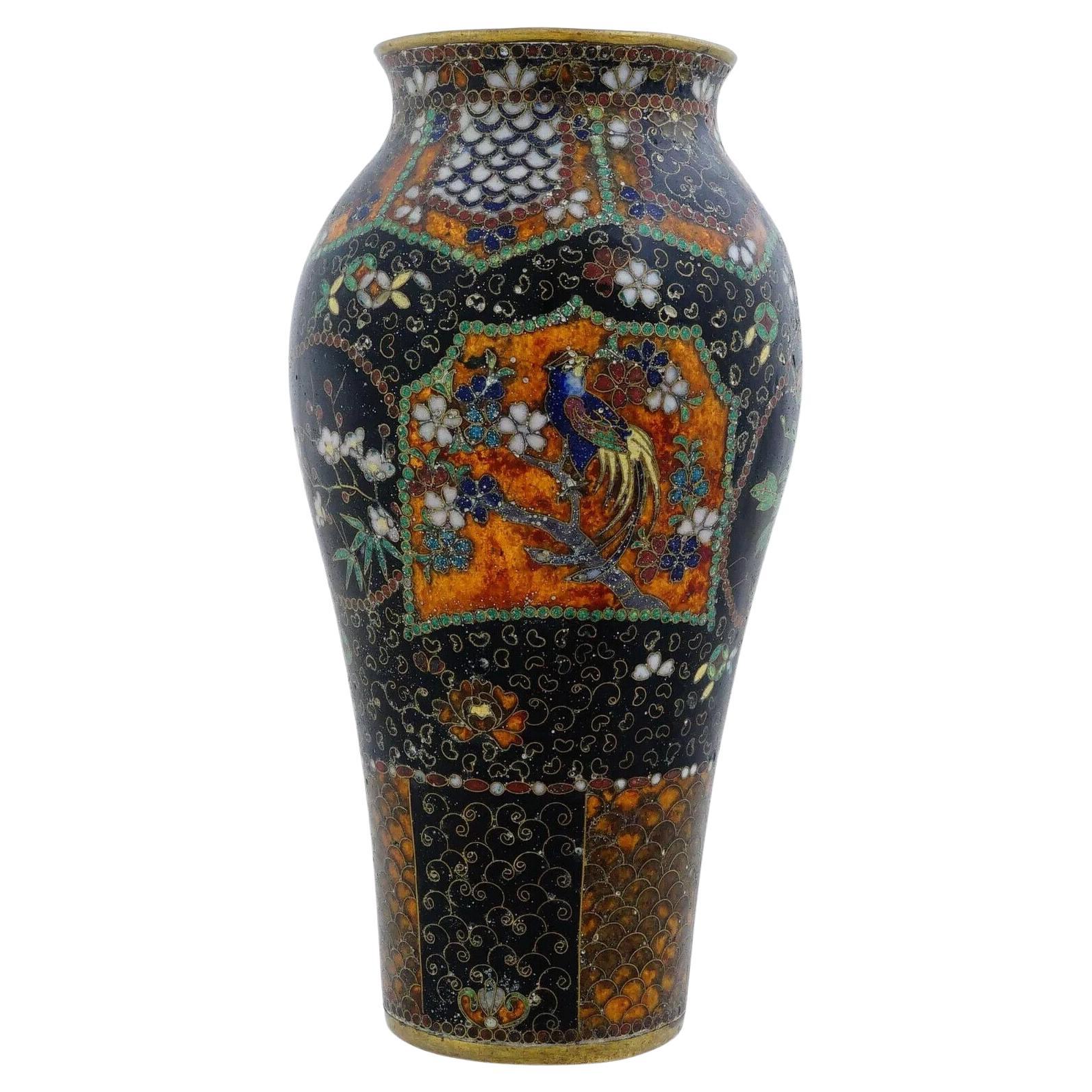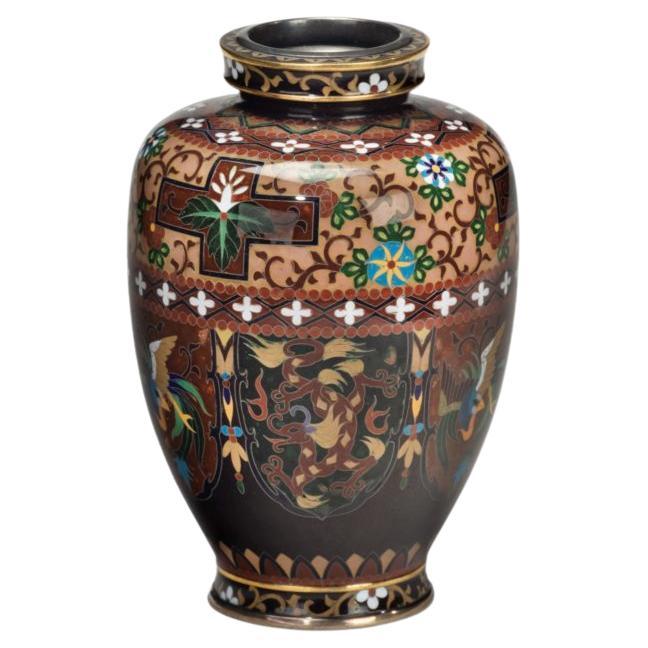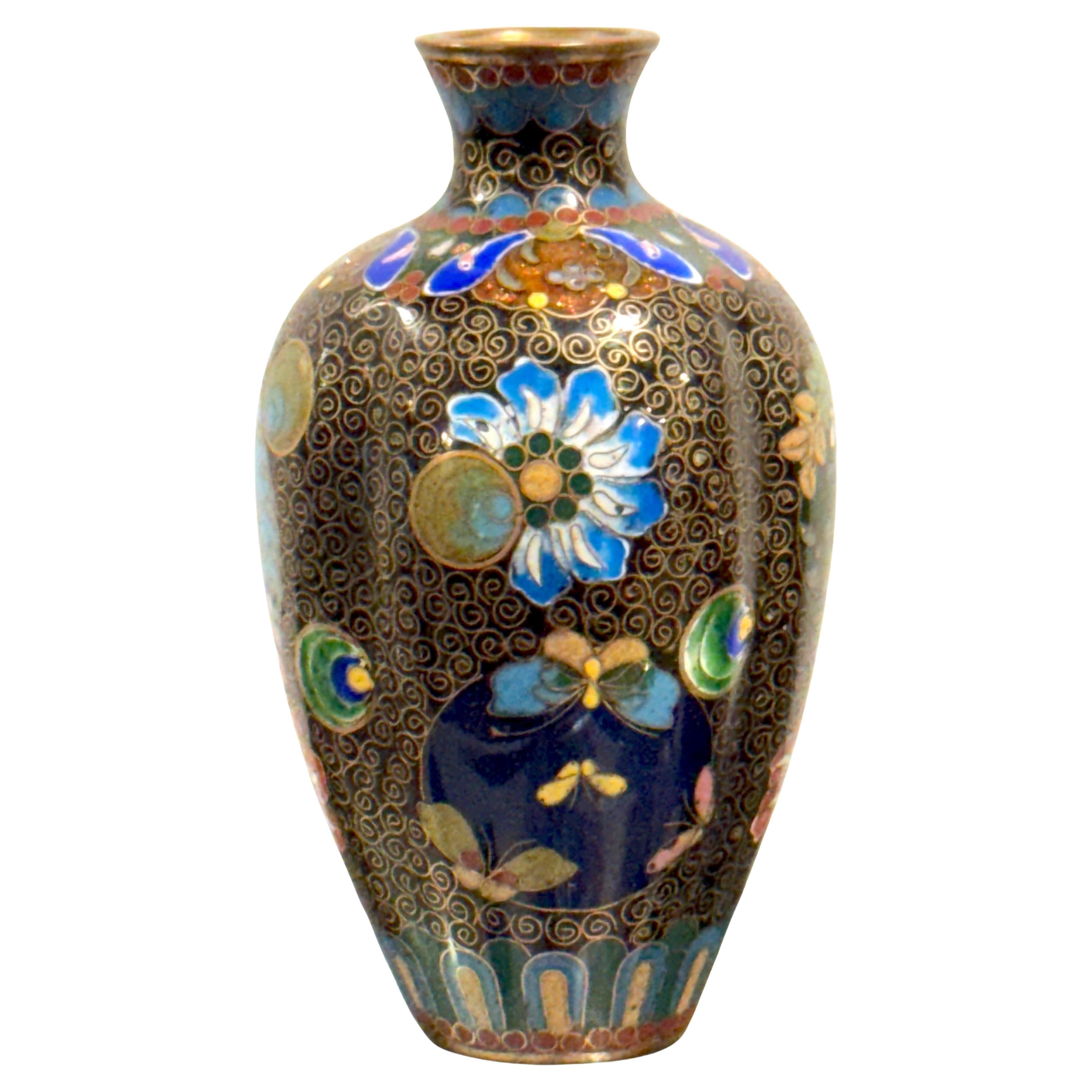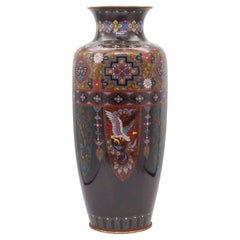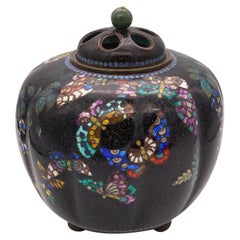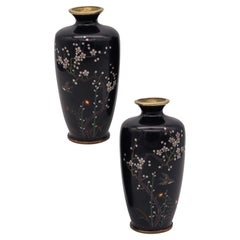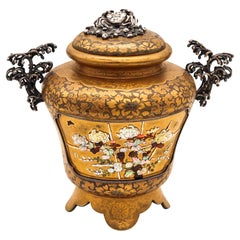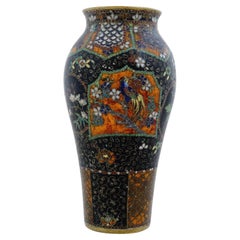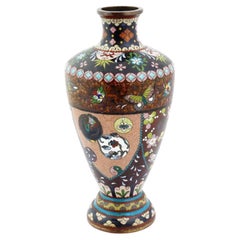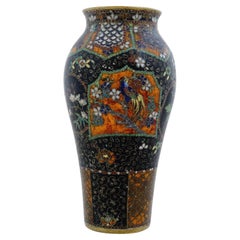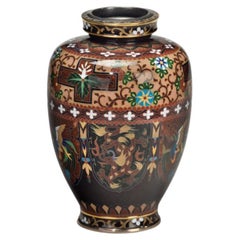Items Similar to Japan 1890 Meiji Period Decorative Vase In Cloisonné Enamel With Wood Base
Want more images or videos?
Request additional images or videos from the seller
1 of 7
Japan 1890 Meiji Period Decorative Vase In Cloisonné Enamel With Wood Base
$558.40per set
$698per set20% Off
£426.93per set
£533.66per set20% Off
€491.73per set
€614.67per set20% Off
CA$782.49per set
CA$978.11per set20% Off
A$873.58per set
A$1,091.97per set20% Off
CHF 457.74per set
CHF 572.18per set20% Off
MX$10,693.43per set
MX$13,366.79per set20% Off
NOK 5,813.31per set
NOK 7,266.64per set20% Off
SEK 5,481.21per set
SEK 6,851.52per set20% Off
DKK 3,669.85per set
DKK 4,587.32per set20% Off
About the Item
Japanese vase from the Meiji Period (1868-1912).
Beautiful antique decorative vase, created in Japan during the Meiji period (1868-1912), circa 1890s. It was carefully crafted in solid bronze with copper wires and embellished with applications of polychromatic cloisonné enamel with aventurine and gold flakes, depicting organics and natural motifs such a phoenix bird, a mythic dragon and flowers.
Weight: 240.95 Grams, (0.53 Pounds).
Measurements: Diameter of 89 mm, height of 114 mm (3.5 x 4.5 Inches).
The Meiji Period
This era of Japanese history that extended from October 23, 1868 to July 30, 1912.The Meiji era was the first half of the Empire of Japan, when the Japanese people moved from being an isolated feudal society at risk of colonization by Western powers to the new paradigm of a modern, industrialized nation state and emergent great power, influenced by Western scientific, technological, philosophical, political, legal, and aesthetic ideas. As a result of such wholesale adoption of radically different ideas, the changes to Japan were profound, and affected its social structure, internal politics, economy, military, and foreign relations. The period corresponded to the reign of Emperor Meiji. It was preceded by the Keiō era and was succeeded by the Taishō era, upon the accession of Emperor Taishō.
Cloisonné
This is an enameling technique in which the pattern is formed by wires soldered to the surface of the object to be decorated, which is usually made from copper, forming cells or cloisons, each of which holds a single colour of enamel paste which is then fired, and ground and polished. The champlevé technique also uses an enameling technique, but the cells are formed by carving into the surface ot the object, or in the casting. The cloisonné technique has been in use since the 12th century BC in the west, but the technique did not reach China until the 13th or 14th century. It became popular in China in the 18th century. Initially bronze or brass bodies were used, and in the 19th century copper, at which time the quality of th eitems produced began to decline. Chinese cloisonné is the best known enamel cloisonné, though the Japanese produced large quantities from the mid-19th century, of very high technical quality. In the west the cloisonné technique was revived in the mid 19th century following imports from China, and its use continued in the Art Nouveau and Art Deco periods.
Phoenix
This mythical bird-like creature combines elements of several different animals, birds and fish. It is said to appear only at times of enlightened rule, making it a symbol of peace and stability. Is also a symbol of good fortune and divine wisdom, the phoenix is believed to appear only in times of peace and prosperity bringing with it a message of hope and rebirth. In Japanese culture it also represents the goddess Amaterasu. A sun deity whose presence evokes the vital energy of the sun itself.
Collateral: It is accompanied by a carved wood base from the period.
Condition: The overall condition of this vase is excellent. Beside the little normal wear, there is no damage to the enamel. All parts are secured in the settings. This vase has been carefully inspected to guarantee the condition and authenticity.
INVENTORY REF: D030824XMNN/.5623
- Dimensions:Height: 4.5 in (11.43 cm)Diameter: 3.5 in (8.89 cm)
- Sold As:Set of 2
- Style:Meiji (Of the Period)
- Materials and Techniques:
- Place of Origin:
- Period:
- Date of Manufacture:1890
- Condition:Wear consistent with age and use. The overall condition of this vase is excellent. Beside the little normal wear, there is no damage to the enamel. All parts are secured in the settings. This vase has been carefully inspected to guarantee the condition and authenticity.
- Seller Location:Miami, FL
- Reference Number:Seller: D030824XMNN/.56231stDibs: LU8303238778712
About the Seller
5.0
Gold Seller
Premium sellers maintaining a 4.3+ rating and 24-hour response times
1stDibs seller since 2023
206 sales on 1stDibs
Typical response time: 3 hours
- ShippingRetrieving quote...Shipping from: Miami, FL
- Return Policy
Authenticity Guarantee
In the unlikely event there’s an issue with an item’s authenticity, contact us within 1 year for a full refund. DetailsMoney-Back Guarantee
If your item is not as described, is damaged in transit, or does not arrive, contact us within 7 days for a full refund. Details24-Hour Cancellation
You have a 24-hour grace period in which to reconsider your purchase, with no questions asked.Vetted Professional Sellers
Our world-class sellers must adhere to strict standards for service and quality, maintaining the integrity of our listings.Price-Match Guarantee
If you find that a seller listed the same item for a lower price elsewhere, we’ll match it.Trusted Global Delivery
Our best-in-class carrier network provides specialized shipping options worldwide, including custom delivery.More From This Seller
View AllJAPAN 1890-1900 Meiji Period Decorative Six-sided Vase In Cloisonné Enamel
Located in Miami, FL
Japanese vase from the Meiji Period (1868-1912).
This is a beautiful antique decorative vase created in the imperial Japan during the Meiji period (1868-1912), circa 1890s. It was c...
Category
Antique 1890s Japanese Meiji Metalwork
Materials
Gold, Bronze, Enamel
Japan 1890 Meiji Period Bronze Koro Censer in Cloisonne Enamel with Jade Lid
Located in Miami, FL
Japanese Koro from the Meiji Period (1868-1912).
Beautiful antique ten sides fluted koro censer, created in Japan during the Meiji period (1868-1912), ci...
Category
Antique 1890s Japanese Meiji Metalwork
Materials
Jade, Gold, Silver, Bronze, Enamel
$718 Sale Price / set
20% Off
Ota Jinnoei 1890 Imperial Meiji Period Pair of Cloisonne Cabinet Vases
By Ota Jinnoei
Located in Miami, FL
Pair of cloisonne vases designed by Ota Jinnoei.
Beautiful pair of small cabinet vases, created in Japan circa 1890, during the meiji Imperial period (1868-1912). These vases has ...
Category
Antique 1890s Japanese Meiji Metalwork
Materials
Silver, Bronze, Enamel
$1,996 Sale Price / set
20% Off
Japan 1890 Meiji Shibayama Round Urn in Gilded Wood and Sterling Silver
Located in Miami, FL
Shibayama urm from the Japan meiji (1858-1912) period.
Gorgeous piece of art, created in the imperial Japan during the Meiji period, circa 1890. This is a little urn with a lid crafted in gilded wood, shibayama panels and sterling silver. Composed by a four footed round vase with two sterling silver handles in the shape of trees and the lid on top accented with the figure of a crab in sterling silver. The gilded wood is decorated with flowers, sea patterns and the imperial flower...
Category
Antique 1890s Japanese Meiji Antiquities
Materials
Multi-gemstone, Gold, Silver, Sterling Silver, Gold Leaf
$5,588 Sale Price / set
20% Off
Ando Jubei Japan 1950 Showa Period Cloisonné Enamel Green Bombe Vase
By Ando Jubei
Located in Miami, FL
Cloisonné enamel vase designed by Ando Jubei.
Beautiful piece of Japanese decorative arts, created by the Ando Jubei Company during the Showa...
Category
Vintage 1950s Japanese Showa Vases
Materials
Silver, Enamel
$1,198 Sale Price
20% Off
China Republic 1912-1960 Inside Paint Carved Rock Crystal Vase Silver & Enamel
Located in Miami, FL
An impressive China inside-painted vase in rock crystal.
Beautiful and one-of-a-kind art-piece. created in China during the first years of the China-republic, circa 1912-1949. Thi...
Category
Vintage 1940s Chinese Chinese Export Antiquities
Materials
Multi-gemstone, Rock Crystal, Silver, Sterling Silver, Enamel
$15,880 Sale Price / set
20% Off
You May Also Like
Antique Japanese Meiji Period Cloisonne Enamel Vase
Located in Long Island City, NY
An antique Japanese Meiji period cloisonne enamel vase. Baluster shaped vase richly adorned with multicolor floral motifs within swirl and scale like patterns. Decorated with a few m...
Category
Antique Late 19th Century Japanese Meiji Metalwork
Materials
Enamel
Meiji Japanese Cloisonne Enamel Medallions Design Vase
Located in Long Island City, NY
A Japanese footed enamel over copper vase. The urn shaped vase is enameled with polychrome medallions representing floral, foliage, foliate scroll, butterfly and Phoenix bird ornamen...
Category
Early 20th Century Japanese Metalwork
Materials
Enamel, Copper
Antique Early Meiji Japanese Cloisonne Enamel Translucent Vase
Located in Long Island City, NY
An antique Japanese Meiji period cloisonne enamel vase. Baluster shaped vase richly adorned with multicolor floral motifs within swirl and scale like patterns. Decorated with a few m...
Category
Antique Late 19th Century Japanese Meiji Vases
Materials
Enamel
A small fine quality Meiji period cloisonné enamel vase
Located in Lymington, Hampshire
A small fine quality Meiji period cloisonne enamel vase, with silver wires and gilt rims decorated with lappets of dragons of ho-ho birds on a brown ground, with textile designs arou...
Category
Antique 1880s Japanese Meiji Metalwork
Materials
Metal
Meiji Period Cloisonne Bulbous Cabinet Vase
Located in West Palm Beach, FL
Meiji Period Japanese Cloisonné Enamel Cabinet Vase, circa 1880
A finely detailed Japanese Meiji period cloisonné cabinet vase, dating to the late 1...
Category
Antique Late 19th Century Japanese Meiji Vases
Materials
Copper
Very Rare Antique Japanese Meiji Era (late 1800's) Cloisonné Vase 24"
Located in Portland, OR
Available from Shogun's Gallery in Portland, Oregon for over 40 years specializing in Asian Arts & Antiques.
This is a unique Japanese Meiji era (c. 1890) ornate Cloisonné vase. Mad...
Category
Antique Late 19th Century Japanese Metalwork
Materials
Copper, Enamel
More Ways To Browse
Japanese Base
Carved Wood Base
Japanese Wood Crafts
1890 Japan
Japanese Art Nouveau
Meiji Wood
Meiji Wood Furniture
Japanese Wood Vase
Antique Wood Fish
Asian Vase With Birds
Carved Wood 19th Century Japanese
Japanese Carved Flower
Large Wood Fish
Wood Furniture With Animal Motif
Gold Enamel Dragon
18th Century Asia Brass
Asian Goddess
18th Century Japanese Vase
